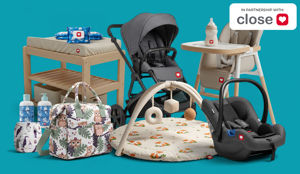Watching your baby hit their first milestones is one of the most exciting parts of being a new parent. It can make all of those sleepless newborn nights worth it!
One of the key moments in their early development is when they learn to roll over. This skill marks the beginning of their mobility and opens the door to even more exciting milestones like crawling and walking. But when can you expect your baby to start rolling over? Let’s look into the details of this fascinating developmental stage.
When Do Babies Typically Roll Over?
Rolling over is usually one of the first major physical milestones that babies master. While every baby is different and develops at their own pace, most little ones begin to roll over between 4 and 6 months of age.
Some may start as early as 3 months, while others might take a bit longer, closer to 7 or 8 months. It’s important to remember that variations are perfectly normal, and a later timeline doesn’t necessarily indicate any developmental issues.
Initially, your baby might roll from their tummy to their back as this requires less strength and coordination. Rolling from back to tummy typically takes a bit more time as it involves greater muscle development, particularly in the neck, arms, and core. Don’t worry if this doesn’t come for a while!
Read More: Lovevery Storyteller Play Kit Review
Signs Your Baby Is Ready to Roll
Before your baby actually rolls over, they’ll show several signs that indicate they’re building the necessary muscles and coordination.
Look out for these key indicators:
- Increased Head Control: Around 3 to 4 months, your little one will likely begin to have better control of their head movements. They will lift their head while lying on their tummy and hold it up steadily.
- Pushing Up: During tummy time, your baby will start to push up on their arms. This not only strengthens their arm muscles but also helps develop the muscles in their chest and back, which are crucial for rolling over.
- Rocking from Side to Side: You might notice your baby rocking their body from side to side when lying on their back. This motion is often comes before rolling over, as it helps them build the coordination needed to flip over.
- Grabbing Their Feet: Babies often discover their feet around 4 to 5 months. This newfound interest in their toes can lead to movements that eventually help them roll over.
Read More: 3 Ways to Promote Baby Development
Encouraging Your Baby to Roll Over
While rolling over is a natural development that will happen in its own time, there are a few ways you can encourage your baby to reach this milestone:
- Tummy Time: Ensuring your baby gets plenty of tummy time each day is crucial. This activity helps strengthen the muscles necessary for rolling over. Start with a few minutes several times a day and gradually increase the duration as your baby gets stronger.
- Interactive Play: Use toys to encourage movement. Place a favourite toy just out of reach while your baby is on their tummy. This can motivate them to stretch and move towards the toy, promoting rolling movements.
- Assisted Rolling: Gently help your baby roll from their back to their tummy and vice versa. This can give them a sense of the movement and help them understand the coordination involved.
- Praise and Encouragement: Always cheer your baby on and celebrate their efforts, even if they don’t fully roll over! Positive reinforcement can boost their confidence and encourage them to keep trying.
When to Be Concerned
While variations in the timeline of rolling over are normal, if your baby hasn’t started to show any signs of rolling over by around 6 months, it’s a good idea to mention it to your doctor. They can assess whether there are any underlying issues.
Remember, every baby is unique and will reach milestones in their own time. It’s important to provide a supportive and encouraging environment without placing undue pressure on them.
Celebrate each small victory along the way, and cherish these precious moments as your baby grows and develops! Head here for 3 Ways to Promote Baby Development.






